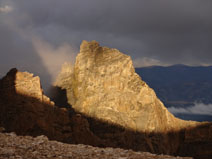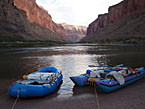Copyright & Revisions: Original copyright © 2006. Reformatted in 2013. No changes made to text.
Publication History: Prepared in response to a request from the Idaho Parks and Recreation Department for papers deliberating on the value of outdoor recreation.
Reproduction Information: You are welcome to provide links to this page or to use short quotations and paraphrases in other documents as long as they appropriately reference the source. There is no charge for non-profit organizations to reproduce or publish extensive parts or all of this paper, but please obtain advanced permission from Ron Watters (wattron@isu.edu). Photo credits: Ron Watters.
It was the second morning of the journey. We were re-tracing the Lewis and Clark trail, high in the Bitterroots, the most primitive and most remote part of their route that remains two hundred years after their famous expedition. We mounted our mountain bikes, and wobbling under the weight of our panniers, started off down the narrow dirt road into a dark, heavy fog.
After about an hour of peddling, the sky gradually brightened, the fog lifted, and suddenly, there it was: the Bitterroot Range with its great sweeping tree-covered slopes, plunging down and down, and disappearing in the misty depths of the Lochsa River canyon.
It was arresting, a moment of great clarity. It was, I guess, an epiphany. Suddenly things made sense. It wasn't until then, until that very moment when the fog lifted and I could see the surrounding mountain wilderness, that I really understand the magnitude of Lewis and Clark's undertaking. Yes. I knew about Lewis and Clark, but it wasn't until then that I really understood Lewis and Clark.
I have been in education all of my life, and I've always believed that for the learning process to be effective it has to be related to life experiences. Physics has no meaning until you understand that its basic principles enable your car to speed down the interstate. Math is an abstract thought until you use it to balance your checkbook, and history is just words in a dusty, old textbook until you learn that your great grandfather died in a trench in France during the first World War.
Connect learning with real life and it comes alive. Mark Twin put it well when he said: "If you hold a cat by the tail you learn things you cannot learn any other way." And so it is with outdoor recreational experiences. In a sense in the outdoors, you are holding the cat by the tail.
I had read some about Lewis and Clark, and I had stopped now and then at roadside historical signs. In fact, living in the west I'd seen and heard a lot about Lewis and Clark, but that might have been the problem. The two explorers were just so common, so much a part of the western historical landscape, that they really didn't hold much more than a passing interest to me.
That didn't change when my good Alaskan friend Jerry Dixon told me of his plans to undertake a journey by foot, boat and bike to retrace the western part of the Lewis and Clark journey from the Gates of the Rockies to the mouth of the Columbia. Nor did it change when Jerry invited me to join him for a part of the journey to ride mountain bikes for a 100-mile stretch through the Bitterroots. And still my attitude didn't change after the first day of riding up and over Lolo Pass and veering off and climbing to where the Lewis and Clark trail followed the spine of the Bitterroots. The two explorers weren't much more to me than just a couple of guys dressed in buckskin, two silhouettes on a highway sign.
No longer. At that moment, high in the Bitterroots, when the fog lifted and when I stopped my bike and looked down at that incredible sight of mountains, of endless mountains, of mountains going on and on into the hazy distance, and of forests, thick and tangled with dead fall, and of deep and dark and misty canyons -- it wasn't until then I felt the immensity of it all. I had been transported back in time and was suddenly in their shoes. I shivered with same anxiety that they felt: when will it all end? Sergeant Patrick Gass of the Lewis and Clark party summed up the foreboding which permeated their thoughts, describing the Bitterroots as "the most terrible mountains I ever beheld."
It is times such as these which are so important in the learning process: times when you experience something for yourself and suddenly things crystallize and take on meanings for you personally. Nothing is better than experience. Nothing. The ancient Chinese philosophers had it right when they said: "I hear and I forget. I see and I remember. I do and I understand."
Doing things outdoors: riding bikes, hiking, skiing, boating enables you to have such experiences. What is better than breathing in fresh air and spending time in the natural world? It is hundreds of times better for our souls than sitting in front of computer monitors and television screens. By being active, by immersing ourselves in activity, we complete the Chinese formula for learning: "I do and I understand."
Moreover, such experiences can jump start the process of learning. After I had completed the mountain bike through the Bitterroots, I was eager to learn more. I stopped in the library and read parts of Lewis and Clark's journals. I looked at copies of their maps and compared them to present day maps. I re-read a copy of Stephen E. Ambrose's wonderfully done Undaunted Courage, and I picked up and read several books which concentrated on Lewis and Clark's journey through the Bitterroots.
Scientific research on the topic is building, and we are finding out more and more how important the natural world is to process of learning and our well being. In particular, the research on children is very telling. Researcher Nancy Wells of New York State College reports an improvement of cognitive functioning in urban children by increasing their exposure to green, natural environments. Another study shows that exposure to nature results in less aggressive behavior. An increasing body of research finds strong correlations between experiences in nature and stress reduction.
Studies by the Human-Environment Research Laboratory at the University of Illinois have concluded that time spent in natural settings can reduce Attention Deficit Hyperactivity Disorder (ADHD). The Illinois research team has even advocated including exposure to nature as one of the treatment regimes for children with ADHD.
Why would the natural world be so beneficial to children? Why would something as simple as exposure to nature be an alternative to drug therapy in the treatment of ADHD? No one knows for sure, but it may be that the outdoor environment is hardwired into our system: spending time in nature -- outdoor recreation, if you will -- is as basic and old as the human race.
As the human raced evolved, children were always engaged in active and mentally stimulating play in the outdoors: they rolled, crawled, somersaulted, skipped, jumped, ran, climbed and played with siblings and other children. When old enough, they chased animals, dug bulbs, gathered plants, fetched water and assisted with shelter building. This took place for thousands of years and it wasn't until recently that children have been sedentary and largely removed from the natural setting.
What does that say about outdoor recreation? It is vital for our children's health, vital for learning and their physical and mental development. It is equally vital for adults. Not only does time in the outdoors give us experiences which help cement and stimulate our own learning, it is, of course, good for our souls.
In this fast-paced, digital world, we must not forget the importance of spending time in the outdoors. Yes, we need to work to support our families, and, yes, children need to buckle down and study.
This is a competitive world. But, we also need to take time off now and then to spend time in the outdoors. That means turning off the television, shutting down the computer, and grabbing your fishing pole, your boat, your hiking boots, your sketch pad, your skis, and most important, yourself. Get out there. Grab the cat by the tail. Return to your natural roots. Do and understand.
[END] |


